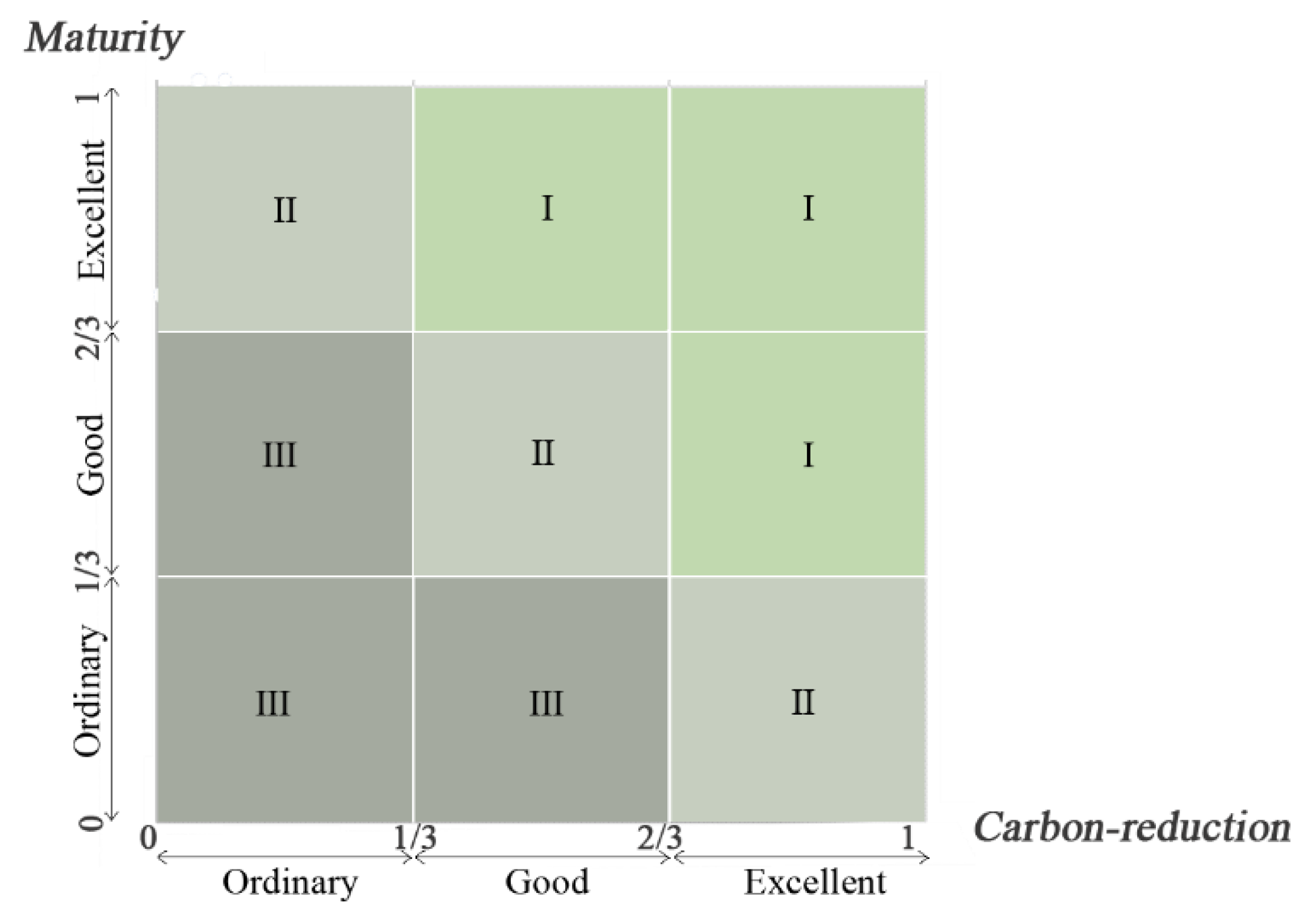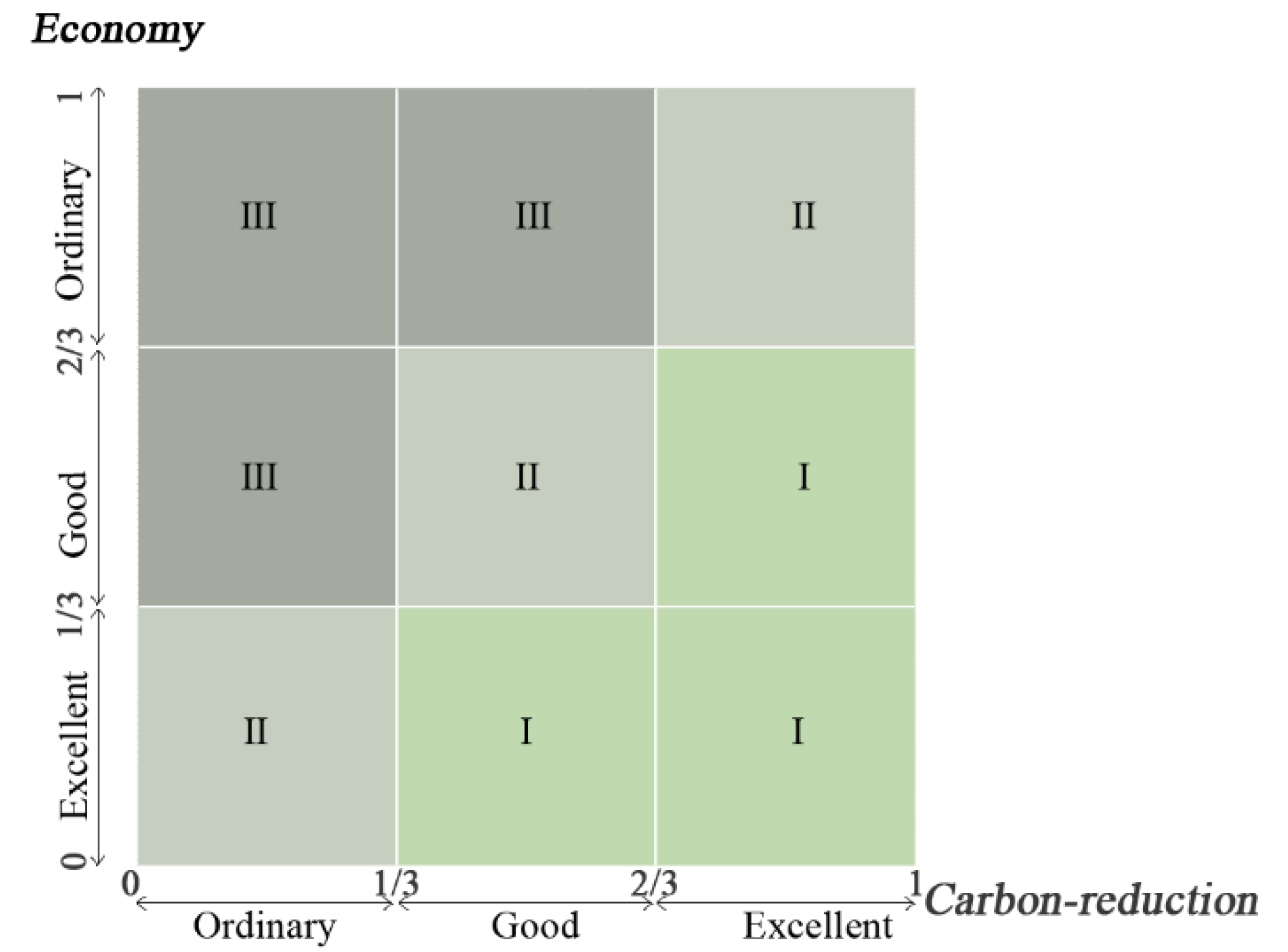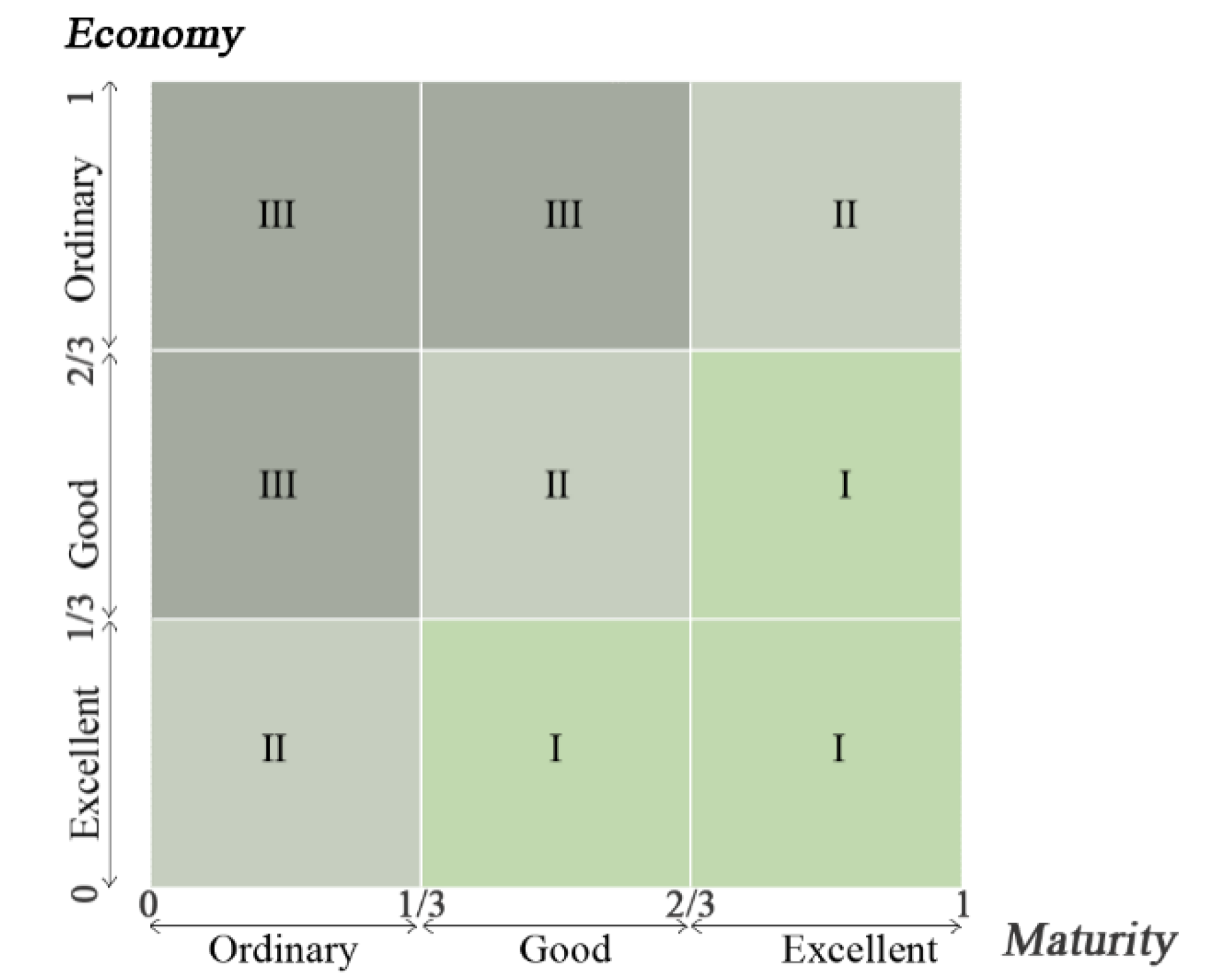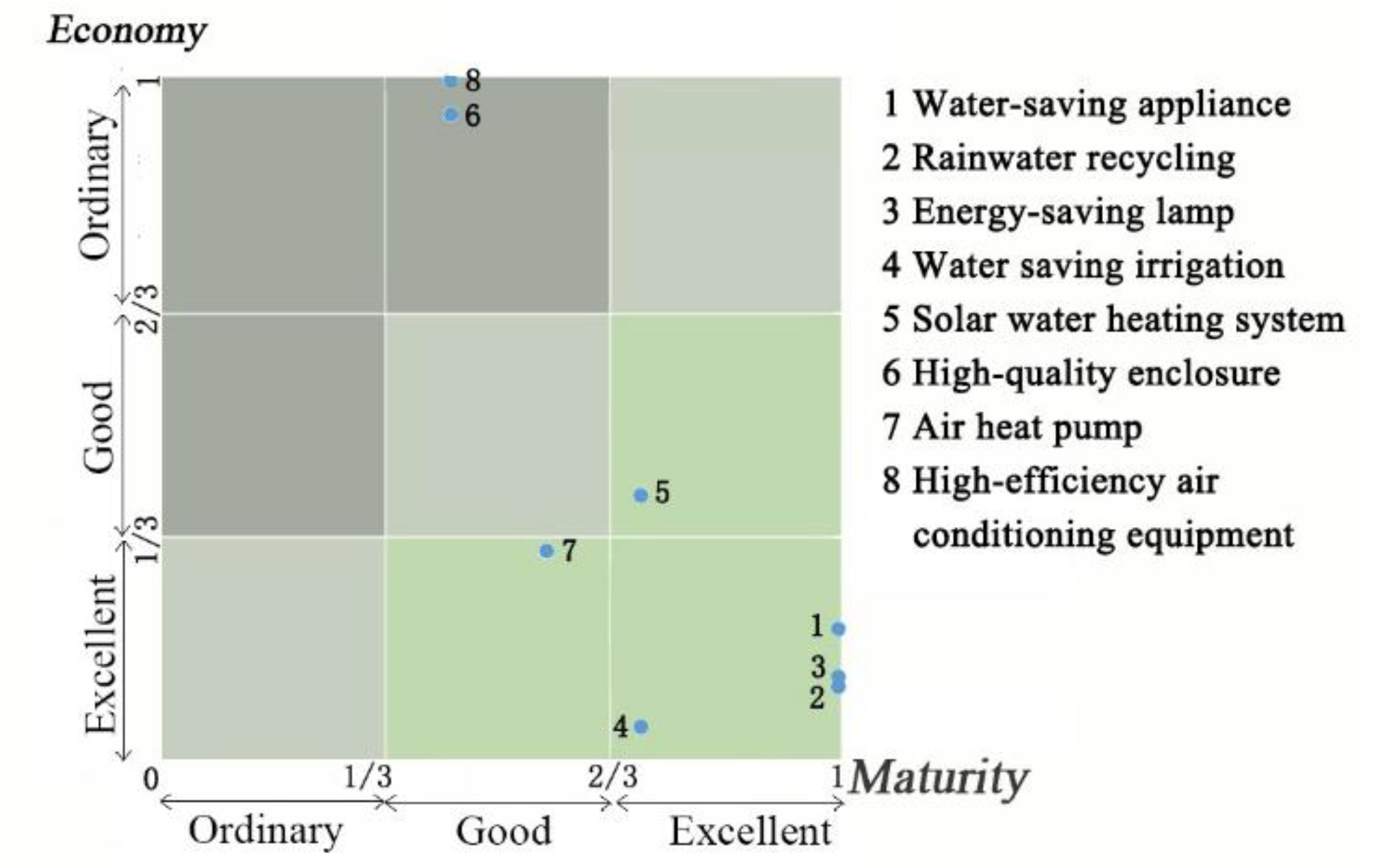Evaluation Model and Strategy for Selecting Carbon Reduction Technology for Campus Buildings in Primary and Middle Schools in the Yangtze River Delta Region, China
Abstract
1. Introduction
2. Method
2.1. Technology List
2.2. Evaluation Model
2.2.1. Carbon Reduction Degree
2.2.2. Maturity Degree
2.2.3. Economy Degree
2.2.4. Multi-Index Evaluation System
3. Case Study
3.1. Case and Technology Selected
3.2. Carbon Reduction Degree
3.3. Maturity Degree
3.4. Economy Degree
4. Results and Discussion
4.1. Results of Three-Dimensional Evaluation
4.2. Optimisation Strategy of Eight Technologies
5. Conclusions
Author Contributions
Funding
Acknowledgments
Conflicts of Interest
References
- Huang, W.M.; Lee, G.W.M. Feasibility analysis of GHG reduction target: Lessons from Taiwan’s energy policy. Renew. Sustain. Energy Rev. 2009, 13, 2621–2628. [Google Scholar] [CrossRef]
- Kuramochi, T.; Wakiyama, T.; Kuriyama, A. Assessment of national greenhouse gas mitigation targets for 2030 through meta-analysis of bottom-up energy and emission scenarios: A case of Japan. Renew. Sustain. Energy Rev. 2017, 77, 924–944. [Google Scholar] [CrossRef]
- Carbon Brief Research Institute. Available online: https://www.carbonbrief.org/ (accessed on 11 October 2019).
- IPCC. Climate Change 2014: Mitigation of climate change. Available online: https://www.ipcc.ch/site/assets/uploads/2018/02/ipcc_wg3_ar5_frontmatter.pdf (accessed on 11 October 2019).
- Wu, Y.; Liang, J. China’s Energy Development Strategy and Building Energy Conservation. Chongqing Arch. 2006, 3, 6–19. (In Chinese) [Google Scholar]
- Ministry of Education of the People’s Republic of China. Available online: http://www.moe.gov.cn (accessed on 11 October 2019).
- Zhang, X.Y.; Wang, F.L. Life-cycle assessment and control measures for carbon emissions of typical buildings in China. Build. Environ. 2015, 86, 89–97. [Google Scholar] [CrossRef]
- Ramesh, T.; Prakash, R.; Shukla, K.K. Life cycle energy analysis of buildings: An overview. Energy Build. 2010, 42, 1592–1600. [Google Scholar] [CrossRef]
- Cabeza, L.F.; Rincón, L.; Vilariño, V.; Pérez, G.; Castell, A. Life cycle assessment (LCA) and life cycle energy analysis (LCEA) of buildings and the building sector: A review. Renew. Sustain. Energy Rev. 2014, 29, 394–416. [Google Scholar] [CrossRef]
- Dowd, R.M.; Mourshed, M. Low carbon buildings: Sensitivity of thermal properties of opaque envelope construction and glazing. Energy Procedia 2015, 75, 1284–1289. [Google Scholar] [CrossRef]
- Vincent, J.L.G.; Deng, M.; Tse, K.T.; ChanIrene, C.M.; LoJack, M.C.; Cheng, C.P. Holistic BIM framework for sustainable low carbon design of high-rise buildings. J. Clean. Prod. 2018, 195, 1091–1104. [Google Scholar]
- Kim, R.; Tae, S.; Roh, S. Development of low carbon durability design for green apartment buildings in South Korea. Renew. Sustain. Energy Rev. 2017, 77, 263–272. [Google Scholar] [CrossRef]
- Saroglou, T.; Theodosiou, T.; Givoni, B.; Meir, I.A. A study of different envelope scenarios towards low carbon high-rise buildings in the Mediterranean climate—Can DSF be part of the solution? Renew. Sustain. Energy Rev. 2019, 113, 109237. [Google Scholar] [CrossRef]
- Rodrigues, V.; Martins, A.A.; Nunes, M.I.; Quintas, A.; Mata, T.M.; Caetano, N.S. LCA of constructing an industrial building: Focus on embodied carbon and energy. Energy Procedia 2018, 153, 420–425. [Google Scholar] [CrossRef]
- Xia, B.; Li, X. Analysis and comparison on the potential of low-carbon architectural design strategies. Sustain. Comput. Inform. Syst. 2019, 21, 204–211. [Google Scholar] [CrossRef]
- Zhang, L.Y.; Li, Q.; Zhou, J.L. Critical factors of low-carbon building development in China’s urban area. J. Clean. Prod. 2017, 142, 3075–3082. [Google Scholar] [CrossRef]
- Jenkins, D.P.; Peacock, A.D.; Banfill, P.F.G. Will future low-carbon schools in the UK have an overheating problem? Build. Environ. 2009, 44, 490–501. [Google Scholar] [CrossRef]
- Pereira, L.D.; Raimondo, D.; Corgnati, S.P.; da Silva, M.G. Energy consumption in schools—A review paper. Renew. Sustain. Energy Rev. 2014, 40, 911–922. [Google Scholar] [CrossRef]
- Stazi, F.; Naspi, F.; Dorazio, M. Modelling window status in school classrooms. Results from a case study in Italy. Build. Environ. 2017, 111, 24–32. [Google Scholar] [CrossRef]
- Zhang, A.; Bokel, R.; Dobbelsteen, A.V.D.; Sun, Y.; Huang, Q.; Zhang, Q. An integrated school and schoolyard design method for summer thermal comfort and energy efficiency in Northern China. Build. Environ. 2017, 124, 369–387. [Google Scholar] [CrossRef]
- Wang, H.; Chen, W. Modeling of energy transformation pathways under current policies, NDCs and enhanced NDCs to achieve 2-degree target. Appl. Energy 2019, 250, 549–557. [Google Scholar] [CrossRef]
- Lindberg, K.B.; Doorman, G.; Fischer, D.; Korpås, M.; Ånestad, A.; Sartori, I. Methodology for optimal energy system design of Zero Energy Buildings using mixed-integer linear programming. Energy Build. 2016, 127, 194–205. [Google Scholar] [CrossRef]
- Koo, C.; Kim, H.; Hong, T. Framework for the analysis of the low-carbon scenario 2020 to achieve the national carbon Emissions reduction target: Focused on educational facilities. Energy Policy 2014, 73, 356–367. [Google Scholar] [CrossRef]
- Suk, S.; Lee, S.Y.; Jeong, Y.S. A survey on the impediments to low carbon technology investment of the petrochemical industry in Korea. J. Clean. Prod. 2016, 133, 576–588. [Google Scholar] [CrossRef]
- Pei, A.; Xin, H. Written on the Occasion of the Promulgation of the Outline of the Development Plan for Regional Integration in the Yangtze River Delta. Xinhua News Agency. 2 December 2019. Available online: http://www.gov.cn/xinwen/2019-12/02/content_5457665.htm (accessed on 15 December 2019).
- National Bureau of Education of Statistics. Available online: http://data.stats.gov.cn/ (accessed on 11 October 2019).
- Green Building Evaluation Standards GB/T50378-2014. Available online: https://max.book118.com/html/2018/1006/5142123233001320.shtm (accessed on 11 October 2019).
- Assessment Standard for Green Campus GB/T 51356-2019. Available online: http://www.jianbiaoku.com/webarbs/book/138896/4047399.shtml (accessed on 11 October 2019).
- Design Standard for Energy Efficiency of Public Buildings (GB50189-2015). Available online: http://www.doc88.com/p-8179113470165.html (accessed on 11 October 2019).
- Ge, J.; Luo, X.Y.; Lu, J. Evaluation system and case study for carbon emission of villages in Yangtze River Delta region of China. J. Clean. Prod. 2017, 153, 220–229. [Google Scholar] [CrossRef]
- The Report of China Building Energy Research by China Association of Building Energy Efficiency. Available online: http://www.cabee.org/site/content/22960.html (accessed on 11 October 2019).
- Zhang, M.M.; Wang, Q.W.; Zhou, D.; Ding, H. Evaluating uncertain investment decisions in low-carbon transition toward renewable energy. Appl. Energy 2019, 240, 1049–1060. [Google Scholar] [CrossRef]
- The Public Post of Cases (Used in the Research). Available online: http://jst.zj.gov.cn/ (accessed on 4 January 2020).
- Xiao, J. Study on Post Occupancy Evaluation of Green Public Buildings. Master’s Thesis, Tsinghua University, Beijing, China, 2013. [Google Scholar]
- Asdrubali, F.; Ballarini, I.; Corrado, V.; Evangelisti, L.; Grazieschi, G.; Guattari, C. Energy and environmental payback times for an NZEB retrofit. Build. Environ. 2019, 147, 461–472. [Google Scholar] [CrossRef]






| Carbon Reduction Types | Technology Type | Technologies | Practice |
|---|---|---|---|
| Water Resource Saving | High-performance appliances | Campus water saving irrigation | • Drip irrigation, sprinkler irrigation, filtration irrigation • Devices such as soil moisture sensors |
| Renewable energy use | Rainwater recycling | • Recycling rainwater from roads and playgrounds for green irrigation and road flushing | |
| High-performance appliances | Secondary water saving appliances | • The indicators meet the specific requirements of the national water saving domestic water appliances standards for each appliance. For example, the flow rate of the nozzle should not be less than 0.125 L per second and the flushing valve of the toilet should not be less than 5 L. For urinal flushing, the single flush water volume of the valve should not be less than 3 L, etc. | |
| Electricity Saving | High-performance equipment | Energy saving lamps | • Use of energy saving lamps (such as LED lamps) to improve power efficiency |
| High-performance equipment | High-quality enclosure (HQE) | • The use of materials such as thermal insulation layers ensures that the maintenance structure of each part of the building meets the specified indicators in the ‘Design Standard for the Energy Efficiency of Public Buildings (GB50189-2015) [29]’ | |
| Renewable energy use | Air-heat pumps | • Use of air-source heat pumps to provide a certain amount of electricity or domestic hot water heating | |
| Renewable energy use | Solar water heating systems | • Solar photovoltaic panels, collectors, etc. | |
| High-performance equipment | High efficiency air conditioning equipment (HEAE) | • Equipment with high-energy efficiencyair conditioning units |
| Recommendation Level in Carbon reduction–Maturity Evaluation | Recommendation Level in Maturity–Economy Evaluation | Recommendation Level in Carbon Reduction–Economy Evaluation | Final Recommendation Level |
|---|---|---|---|
| High | High | High | High |
| High | High | Moderate | |
| High | High | Poor | |
| High | Moderate | High | |
| High | Poor | High | |
| Moderate | High | High | |
| Poor | High | High | |
| High | Moderate | Poor | Moderate |
| High | Poor | Moderate | |
| Moderate | High | Poor | |
| Moderate | Poor | High | |
| Poor | Moderate | High | |
| Poor | High | Moderate | |
| High | Moderate | Moderate | |
| Moderate | High | Moderate | |
| Moderate | Moderate | High | |
| Moderate | Moderate | Moderate | |
| Moderate | Moderate | Poor | |
| Moderate | Poor | Moderate | |
| Poor | Moderate | Moderate | |
| Poor | Poor | High | Poor |
| Poor | Poor | Moderate | |
| Poor | Poor | Poor | |
| Poor | High | Poor | |
| Poor | Moderate | Poor | |
| High | Poor | Poor | |
| Moderate | Poor | Poor |
| Number | Case Names | Location | Volume Rate | Number of Teachers and Students |
|---|---|---|---|---|
| 1 | Haining Maqiao Central Primary School Reconstruction Project | Jiaxing | 0.69 | 1100 |
| 2 | Hangzhou Olive Tree Foreign Language School | Hangzhou | 1.00 | 1578 |
| 3 | Huzhou Binhu Primary School | Huzhou | 0.57 | 2300 |
| 4 | New construction at Xiangyang Primary School North Campus | Jiaxing | 0.75 | 1600 |
| 5 | Yueqing Baishi Primary School Expansion Project | Wenzhou | 0.62 | 1600 |
| 6 | Jiashan Experimental School affiliated to Shanghai Normal University | Jiaxing | 0.8 | 1350 |
| 7 | Taizhou Yuehu Primary School Project I | Taizhou | 1.6 | 1080 |
| Technology | Cases Name | Average | |||||||
|---|---|---|---|---|---|---|---|---|---|
| Haining Maqiao | Hangzhou Olive Tree | Huzhou Binhu | Xiang Yang | Yueqing Baishi | Jiashan | Taizhou Yuehu | |||
| Water saving irrigation | Carbon reduction rate | 0.03% | 0.20% | 0 | 0.08% | 0.07% | 0.22% | 0 | 0.12% |
| Rainwater recycling | Carbon reduction rate | 0.82% | 1.70% | 0.26% | 0.11% | 0.15% | 0.52% | 0.71% | 0.59% |
| Water saving appliances | Carbon reduction rate | 0.20% | 1.26% | 0.13% | 0.27% | 0.22% | 1.27% | 0.51% | 0.56% |
| Solar water heating systems | Carbon reduction rate | 5.97% | 0 | 2.19% | 4.26% | 0 | 8.62% | 5.33% | 5.26% |
| Energy saving lamps | Carbon reduction rate | 0.62% | 1.63% | 1.27% | 1.20% | 0.74% | 3.36% | 1.42% | 1.47% |
| Air-heat pumps | Carbon reduction rate | 0 | 24.27% | 0 | 12.00% | 9.16% | 0 | 15.14% | 15.14% |
| High quality enclosure (HQE) | Carbon reduction rate | 0.91% | 0.26% | 0.15% | 0.03% | 1.66% | 0.43% | 0.88% | 0.62% |
| High efficiency air conditioning equipment (HEAE) | Carbon reduction rate | 7.34% | 17.50% | 16.88% | 12.40% | 11.16% | 17.20% | 9.56% | 13.15% |
| Technology | Water Saving Irrigation | Rainwater Recycling | Water Saving Appliance | Solar water Heating System | Energy Saving Lamp | Air-Heat Pump | HQE | HEAE |
|---|---|---|---|---|---|---|---|---|
| Average of carbon reduction rates | 0.12% | 0.59% | 0.56% | 5.26% | 1.47% | 15.14% | 0.62% | 13.15% |
| Carbon reduction degree | 0.79% | 3.90% | 3.70% | 34.74% | 9.71% | 100% | 4.10% | 86.86% |
| Technology | Application in Cases | |||||||
|---|---|---|---|---|---|---|---|---|
| Haining Maqiao | Hangzhou Olive Tree | Huzhou Binhu | Xiang Yang | Yueqing Baishi | Jiashan | Taizhou Yuehu | Maturity Degree | |
| Water saving irrigation | √ | √ | √ | √ | √ | 71% | ||
| Rainwater recycling | √ | √ | √ | √ | √ | √ | √ | 100% |
| Water saving appliances | √ | √ | √ | √ | √ | √ | √ | 100% |
| Solar water heating systems | √ | √ | √ | √ | √ | 71% | ||
| Energy saving lamps | √ | √ | √ | √ | √ | √ | √ | 100% |
| Air-heat pumps | √ | √ | √ | √ | 57% | |||
| HQE | √ | √ | √ | 43% | ||||
| HEAE | √ | √ | √ | 43% | ||||
| Technology | Market Price | Incremental Cost (Yuan/m2 of Floor Area) | Economy Degree | |
|---|---|---|---|---|
| Unit Price (Yuan) | Unit | |||
| Water saving irrigation | 35 | Yuan/m2 of green area | 3 | 5% |
| Rainwater recycling | 100,000 | Yuan/Set | 6.7 | 11% |
| Water saving appliances | 50 | Yuan/m2 of lavatory | 12.5 | 19.5% |
| Solar water heating systems | 1000 | Yuan/m2 of solar photovoltaic panels | 25 | 39% |
| Energy saving lamps | 8 | Yuan/m2 of floor area | 8 | 12.5% |
| Air-heat pumps | 300,000 | Yuan/Set | 20 | 31% |
| HQE | 10,000 | Yuan/m2 of enclosure area | 61 | 95% |
| HEAE | 1000 | Yuan/Set | 64 | 100% |
| Technology | Recommendation Level in Carbon Reduction–Maturity Evaluation | Recommendation Level in Carbon Reduction–Economy Evaluation | Recommendation Level in Maturity–Economy Evaluation | Final Recommendation Level |
|---|---|---|---|---|
| Air-heat pumps | High | High | High | High |
| Solar water heating systems | High | Moderate | High | High |
| HEAE | High | Moderate | Poor | Moderate |
| Energy saving lamps | Moderate | Moderate | High | Moderate |
| Rainwater recycling | Moderate | Moderate | High | Moderate |
| Water saving appliances | Moderate | Moderate | High | Moderate |
| Water saving irrigation | Moderate | Moderate | High | Moderate |
| HQE | Poor | Poor | Poor | Poor |
© 2020 by the authors. Licensee MDPI, Basel, Switzerland. This article is an open access article distributed under the terms and conditions of the Creative Commons Attribution (CC BY) license (http://creativecommons.org/licenses/by/4.0/).
Share and Cite
Luo, X.; Ma, C.; Ge, J. Evaluation Model and Strategy for Selecting Carbon Reduction Technology for Campus Buildings in Primary and Middle Schools in the Yangtze River Delta Region, China. Sustainability 2020, 12, 534. https://doi.org/10.3390/su12020534
Luo X, Ma C, Ge J. Evaluation Model and Strategy for Selecting Carbon Reduction Technology for Campus Buildings in Primary and Middle Schools in the Yangtze River Delta Region, China. Sustainability. 2020; 12(2):534. https://doi.org/10.3390/su12020534
Chicago/Turabian StyleLuo, Xiaoyu, Cong Ma, and Jian Ge. 2020. "Evaluation Model and Strategy for Selecting Carbon Reduction Technology for Campus Buildings in Primary and Middle Schools in the Yangtze River Delta Region, China" Sustainability 12, no. 2: 534. https://doi.org/10.3390/su12020534
APA StyleLuo, X., Ma, C., & Ge, J. (2020). Evaluation Model and Strategy for Selecting Carbon Reduction Technology for Campus Buildings in Primary and Middle Schools in the Yangtze River Delta Region, China. Sustainability, 12(2), 534. https://doi.org/10.3390/su12020534




